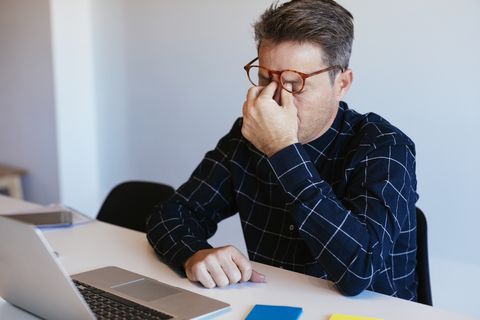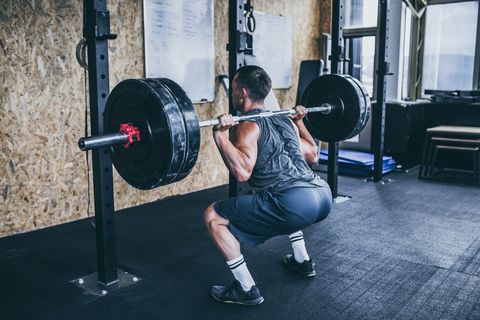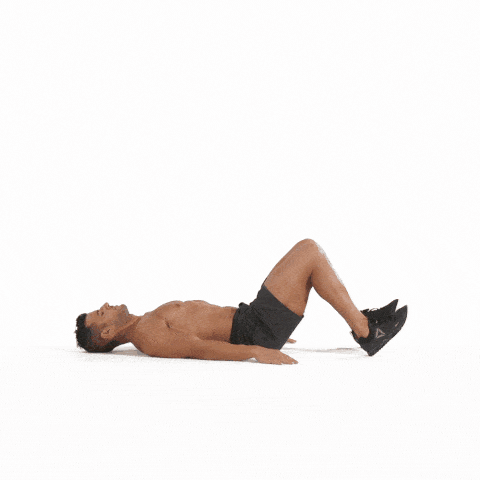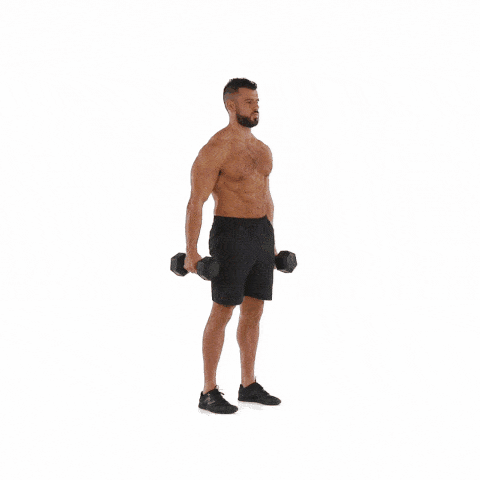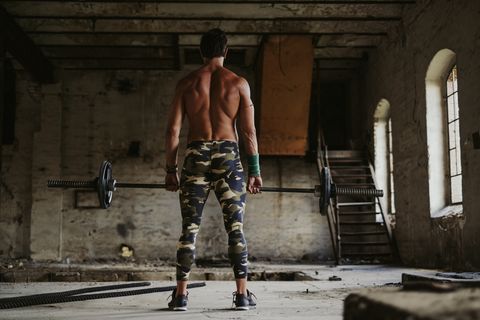
If you spend hours with you rear planted in a chair, you might be at risk of murdering your butt.
You might think this is all a big joke — but dead butt syndrome, a.k.a. gluteal amnesia, is legit. Basically, your butt is still there, but your rear end’s muscles need to be “brought back to life” for you to have any hope of resurrecting your lower body gains.
How Dead Butt Syndrome Happens
The phenomenon happens when the gluteus medius, one of the three major gluteus muscles, isn’t engaged and worked regularly. Without that attention, our biggest butt muscle group stops functioning the way it’s supposed to in order to help us move efficiently.
“Dead butt syndrome is when your gluteus medius stops “firing” – it can’t initiate contraction,” explains Hector Bones, C.P.T. and owner of The PrivatGym in Philadelphia, PA. “[It’s] often related to sitting for a long period of time, where the hip flexors are active; therefore, the glute muscles are inhibited.”
It’s a trade-off. When those hip flexors are super short and tight, the glutes sag. This response is called reciprocal inhibition, and it prevents the muscles from performing while in their lengthened state.
Whose Butt Is at Risk — and Why
Gluteal amnesia can happen to anyone, but some people are at higher risk than others depending on how they spend their days. Bones notes that people with desk jobs that don’t take frequent breaks, commercial drivers, and people with long commutes are more susceptible to dead butt syndrome than others — essentially, anyone who spends a long period of time in sedentary positions.
Getty ImagesWestend61
But they’re not the only people putting their butts at risk. People who display poor posture (hunched/slumped shoulders and weak core) can develop the condition, too. “Poor posture would cause dead butt syndrome because if you’re slumped, and you’re constantly in flexion,” Bones says. “It would put the glutes in a constant stretch [of] not firing [properly].”
Even otherwise active exercisers can be at risk, if they don’t give the whole muscle group enough attention. Runners might develop glute amnesia because pounding pavement is so quad dominant, without much glute activation. This could eventually even compromise a runner’s form and lead to changes in gait, according to Bones.
“Your gluteus medius’ role is to abduct and rotate the leg, but additionally its main function is to support and stabilize your pelvis during walking,” adds Katie Dunlop, C.P.T. and owner of Love Sweat Fitness. “If it isn’t firing like it’s supposed to it can lead to someone overworking the supporting muscles, [which could lead to] lower back, knee and joint pain.”
How to Spot and Solve a Dead Butt
Bones says the dead butt syndrome is easy to spot, once the condition sets in. Symptoms include an anterior pelvic tilt (think of your belt buckle leaning forward) and pain in the hamstring during certain exercises, like a step-up, where you’ll find that the hamstrings are fatiguing more quickly after doing the work typically handled by the glutes.
“Sometimes when I ask a client to pretend they’re pinching a penny between their butt and do a pelvic tilt they are not able to ‘pinch the penny’ because their glute muscles are not working,” says Bones.
Getty ImagesConstantinis
If you think your glutes might be DOA, don’t fear — their demise is only temporary. You can get those muscles firing again with a few simple exercises before a workout, or by making the glutes your main focus on leg day. “I recommend doing all exercises each day or as a warm up before a legs and booty workout,” Dunlop advises. She also recommends implementing stretch bands into your lower body work to reap even more gains from your hard work.
Even if your glutes are in good shape, consistently working to strengthen these muscles can help you avoid dead butt syndrome — and of course, build up a better behind. Try out these moves, no matter who you are.
The Butt Resurrection Routine
Bridges
15 to 20 reps
Men's Health
“Place your feet hip distance apart and press heels into the floor,” says Dunlop. “Tuck the pelvis and press hips toward the sky, engaging your glutes. Lower to hover and repeat.” The move targets the gluteus medius muscles head-on and fires them up quickly, she explains.
Bones also recommends adding bands or even elevating your feet on a stability ball to up the difficulty.
Clam Shells and Hip Abductions
15 to 20 reps each side
“Lie on your side with feet stacked, knees bent at 90 degrees, and abduct the top knee [lift the knee away from your body’s midline], keeping your heels together,” says Bones.
After doing between 15 to 20 reps of clamshells, straighten out the top knee and abduct the leg.
Donkey Kicks
15 to 20 reps each leg
Start on your hands and knees, engaging your core. Keep your gaze down at the ground and flex your right foot. Keeping the knee bent, engage your glutes to lift your foot, pressing your heel to the sky. Lower back to the starting position with control and repeat.
Pause Squat
15 to 20 reps
Men's Health
Begin by standing tall with your feet shoulder width apart. Bend your knees, sitting your hips back with your chest upright. Pause for five counts, squeezing your glutes at the bottom of the movement. Return to standing and repeat.
“So much musculature is involved during [squats],” says Bones. “Squats target quads and glutes, and when performed eccentrically (the lowering part of the exercise) glute activation is firing away.”
Dumbbell/Kettlebell Deadlift
15 to 20 reps
Men's Health
Grab a pair of dumbbells or kettlebells. Begin in a standing upright position with your feet slightly wider than hip width apart and your knees slightly bent, holding the weights with both hands. Hinge at your hips, lowering the weights toward the ground, keeping your spine straight. Once you’ve reached the lowest point you can go without rounding your back or losing your form, reverse the movement.
Deadlifts can be considered the “king” of butt work, according to Bones. The move targets the posterior chain, and you’re getting glute, lower back, and inner thigh activation all in one exercise.
Band Lateral Walks
15 to 20 reps, each direction
Start standing with your feet directly underneath your hips, with the band wrapped around your lower legs. Step sideways to the right as far as you can. Keep pushing your knees outward as you sit low and keep the weight in your heels. Then repeat the motion to the left.
Source: Read Full Article
